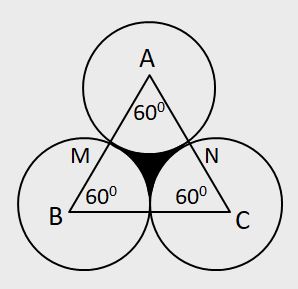|
|
|
View Answer
Shortcut:
There is an equilateral triangle of which each side is 'z' metres. With all the three corners as centres, circles are described each of radius
z
/
2
metres. The area common to all the circles and the triangle is
1
/
8
πz2 or
1
/
2
π(radius)2 and the area of the remaining portion(shaded portion) of the triangle is √3 −
π
/
2
x (radius)2 or (0.162)(radius)2 or, (0.0405)z2

Here, z = 2, r = 1
When the side of the equilateral triangle is double the radius of the circles, all circles touch each other and in such cases the following formula may be used:
Area of each sector =
1
/
6
x π x (radius)2
Area of remaining (shaded) portion = √3 −
π
/
2
x (radius)2
In this question, the area common to all circles and triangle = sum of the area of three sectors AMN, BML and CLN =
1
/
6
x π x (r)2 +
1
/
6
x π x (r)2+
1
/
6
x π x (r)2 =
1
/
2
x π x (r)2
=
1
/
2
x
22
/
7
x (1)2 = 1.57 sq m.
(ii) The area of the remaining portion of the triangle = The area of the shaded portion = 0.162 x (1)2 = 0.162 sq m.
|
|